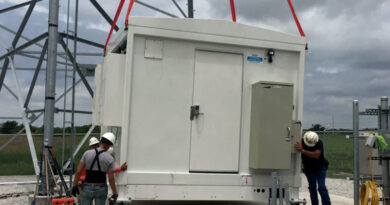Mobile Operator Networks in Transition
By Mark Poletti
We are seeing an industry trend of virtualization and cloudification of 5G core and radio access network (RAN) functions onto a shared compute platform architecture. This is all happening while mobile operators are transitioning from 4G to 5G and non-standalone (NSA) to standalone (SA) core architectures. Mobile operators are faced with several choices of public, private, and hybrid platforms and are driven by their own network make-up, customer base and business goals. This article provides an overview of this trend.
Mobile operators are disaggregating their network
As mobile operators continue to prepare their networks for the latest releases of 5G, they are gradually upgrading their core and radio networks with a virtualized network platform that hosts software-driven network functions. This requires a re-architecture that decouples closed systems, offered by traditional mobile network equipment suppliers, to an open software-based solution that runs on any hardware.
The network re-architecture starts with a flexible computing platform that uses a distributed, shared computing architecture that can be hosted privately or publicly by a managed service. Network functions operate on this platform as microservices or virtual machines. These applications are managed and orchestrated by hypervisor or container orchestrators like Kubernetes. The software is available at scale, depending on resource availability and demand.
Virtualized networks
Virtualized networks are built on the concept of network functions virtualized infrastructure (NFVI), which uses an approach to implement software defined networking (SDN). Virtual network functions (VNFs) replace network hardware with software that can be modified and scaled to deliver 5G features and services. VNFs are network services running as software processes on off-the-shelf server hardware. By virtualizing essential network functions that were previously hard coded to hardware, operators can tailor network performance and deploy new services at scale using only software. Individual VNFs are deployed in the cloud as services, which can work independently or together to provide basic networking functionality.
NFVI is the architecture used for implementing VNFs and is essential to the creation, deployment, and scale of 5G services. VNFs also complement SDNs which includes a network concept that decouples the control plane from the data plane in the network.

Building block for 5G networks
The virtualized network approach provided by VNFs, NFVI, and SDNs are a fundamental building block for the 5G core which uses the 3GPP defined services based architecture (SBA). The SBA is a flat architecture that separates the control plane functions from the user plane functions. The SBA delivers core network services as a set of interconnected network functions (NFs). Services are the building blocks used to create and execute the functions of a mobile network. The SBA replaces the rigid 4G evolved packet core (EPC) with 5G network functions that can operate independently from one another and are free from hardware dependencies. This allows operators to have more flexibility to optimize and grow the network with more freedom to choose vendors and hardware they want to use.
Establishing a foundation with a virtualized network for SBA which uses NFs as the basis for 5G services is key to mobile operator transition. Mobile operators can use these capabilities to provide better network reliability, improved traffic management, lower latency, and responsive load management. The 3GPP approach also allows mobile operators to deliver services reliably, securely, and more efficiently to customers that can be tailored specifically to service needs (i.e., network slicing).

Mobile operators have already begun virtualization
Mobile operators have already embraced the transition to virtualized networks, starting with the core. For example, several tier 1 mobile operators have announced that they are applying 5G core NFs using virtualized platforms, some are fully outsourced, [1]some are open hybrid cloud platforms [2] and some are locally (privately) hosted. [3]
While virtualization of the 5G core is common among legacy mobile operators, they are still working out how to transition the virtualization of the RAN. Their focus has been on a transition strategy to migrate from 4G to 5G and NSA to SA while maintaining cost efficiencies, service delivery and network quality. This starts at the core and builds out towards the RAN. In contrast, new entrants with no network, such as Dish and Rakuten, can directly build a cloud native network from the ground up. This greenfield approach allows them to include virtualization of the RAN in addition to the 5G core based on the availability of virtualized RAN equipment, standards development and maturity of the technology.
As mobile operators virtualize their networks, traditional mobile network suppliers are trending toward software virtualization of network functions and beginning to separate it from hardware. In contrast, we see that new entrant network suppliers (e.g., Mavenir, Altiostar) are investing in cloud hosted architecture and services and are ‘pulling’ the mobile industry away from a closed system mobile infrastructure to more software-based applications that run on any hardware. Such network suppliers are entering a new market traditionally held by the mobile network suppliers by offering virtualized core products and services to a new market.

Partnerships are key to mobile operator success
As the mobile network continues to virtualize and disaggregate, the number of choices of network components and vendors increases. Mobile operators must now consider multiple vendors, interoperability between vendor solutions, and system integration. Selection will be driven by their own network make-up, customer base and business goals and how well this matches up with their current set of vendors. Thus, partnerships will be key to mobile operator success.
- https://telecoms.com/510376/att-sells-its-cloud-soul-to-microsoft/
- https://www.zdnet.com/article/ibm-lands-verizon-telefonica-pacts-as-hybrid-cloud-edge-computing-5g-meld/
- https://www.rcrwireless.com/20211203/5g/telenet-start-gradual-deployment-5g-belgium-next-week

Mark Poletti,
Director of Wireless Technologies,
CableLabs
Shutterstock




